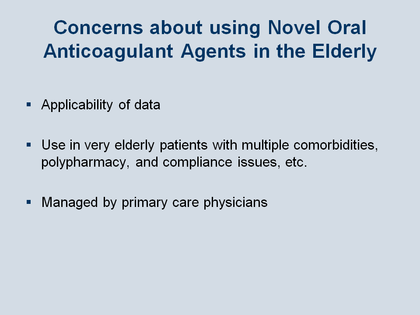William French, MD - Anticoagulation: Special Populations - Figure 7
Using NOACs in the Elderly
Many primary care physicians appear reluctant to initiate antithrombin therapy in older patients with AFib. There were no doubt good reasons for this when the only reliable oral anticoagulant was warfarin, with its many side effects and problems with patients trying to maintain their INR values in the therapeutic range. Even with the introduction of the new NOACs, however, this reluctance to treat appears to persist. As shown in the Figure, this may be because of concerns about the applicability of the date supporting the efficacy and safety of the newer anticoagulation agents, and because of the general difficulty with treating elderly patients with multiple comorbidities, problems with polypharmacy, etc.
There is another important issue, however, in how the NOACs will probably change anticoagulant prophylaxis in AFib patients in the future. In order for these new agents to enter general clinical use, it is important that the speciality groups, such as cardiologists, take responsibility and make a major effort to try to improve the use of antithrombin therapy, for this is what will give reassurance to the primary care physicians that it is an appropriate way to manage patients. This is especially important moving forward, because as introduction of the NOACs with their wide therapeutic ranges makes it less necessary to manage the very narrow therapeutic INR values of warfarin, there will be less need to measure coagulation parameters -- and as a result, patients will no doubt be less likely to be followed by the subspecialists (e.g., cardiologists) and more likely to be followed by their primary care physicians.
In the presenter's case, for example, the plan in our practice is to look forward to closing a 1000-patient anticoagulation clinic, since sooner or later those patients will move to treatment with one of the NOACs, and then they will be followed mainly by their primary care physicians. Thus the introduction of the NOACs should provide an important "window of opportunity" for all physicians who treat patients with AFib.
French WJ. Am J Med 2013; 126: 00-00.

